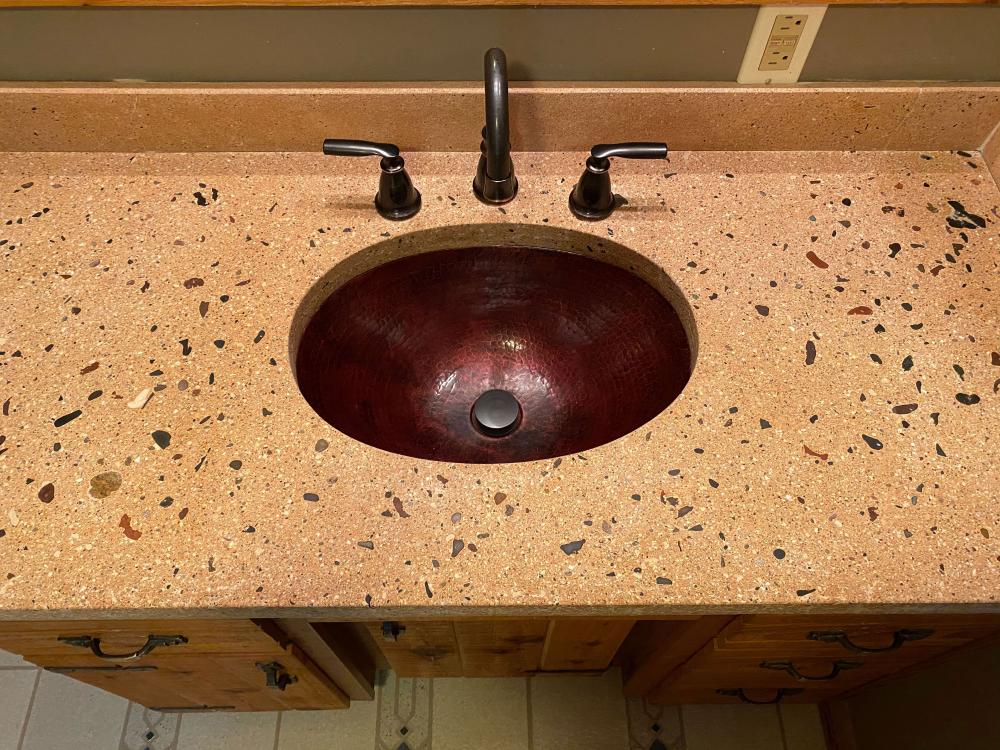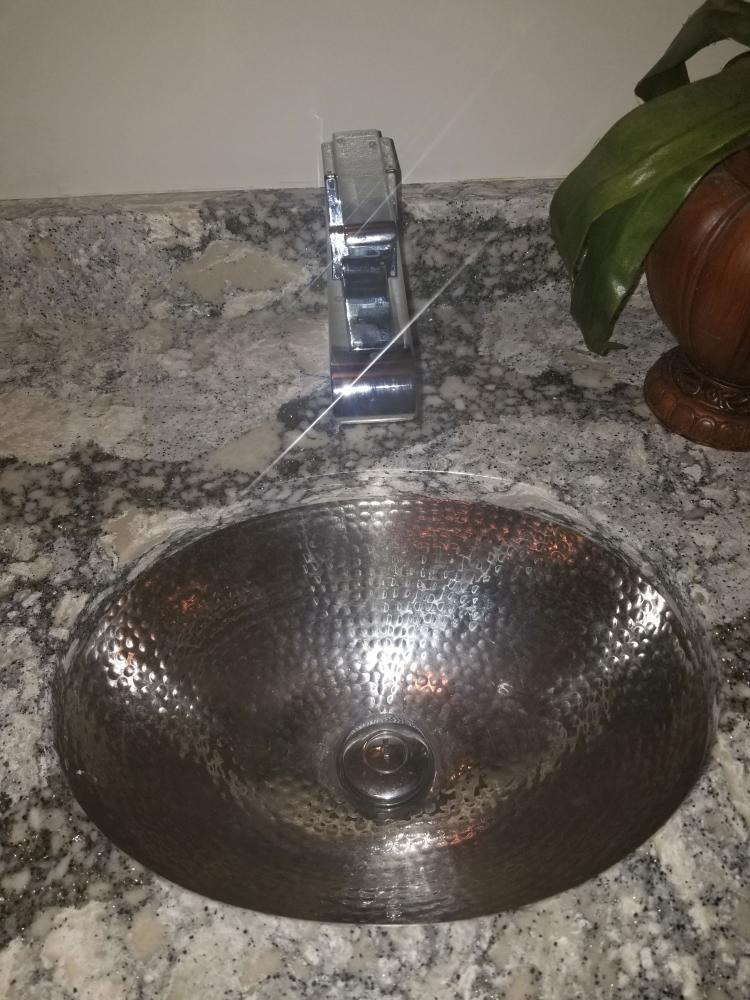Have you noticed that your bathroom faucets have developed discoloration, rust spots, or stubborn buildup that dulls the finish and makes the faucets harder to use? These issues are usually signs of corrosion, a gradual process that can weaken the faucet and shorten its lifespan. Learn what causes bathroom faucets to corrode, as well as the best ways to prevent and treat corrosion.
What Causes Bathroom Faucet Corrosion?

Modern bathroom faucets are engineered to withstand moisture, but several factors can still cause corrosion over time. Recognizing these causes helps you choose durable fixtures and maintain them properly.
Hard Water and Mineral Buildup
Many U.S. households have hard water, which contains elevated levels of dissolved minerals (calcium and magnesium). When hard water flows over a faucet, it leaves behind chalky white deposits that can trap moisture on the metal surface.
Chemical Cleaners and Harsh Substances
Some cleaning products can cause bathroom faucets to corrode faster. Ammonia-based cleaners aggressively attack brass and chrome-plated components, creating stress fissures that promote further corrosion.
Harsh scouring powders and bleach can also damage protective coatings on faucets, exposing the underlying metal to moisture. Even commonly used glass-cleaner sprays can seep under handles and remain trapped, corroding brass or copper parts.
Galvanic Corrosion From Mixed Metals
Many luxury faucets are assembled from multiple metals, such as brass bodies with copper, nickel and chrome plating, or steel washers clamped against brass threads. When dissimilar metals remain in contact with moisture, a small electric current (galvanic action) can accelerate corrosion on the more reactive metal.
Scratches or imperfections in the chrome expose the reactive copper layer, allowing corrosion to progress rapidly under the surface. Using cheap steel washers on some fixtures also causes them to rust quickly. Instead, using stainless steel or brass components throughout and keeping the joints dry will reduce this form of corrosion.
Environmental Factors
Bathrooms are humid environments. Moist air condenses on cool metal surfaces, and tiny scratches or dents in chrome or nickel plating expose the metal beneath to oxygen and moisture. Over decades, protective coatings thin and seals wear out.
How Do You Remove Corrosion From a Bathroom Faucet?
You can usually remove light corrosion on a faucet with household products.
Dissolve Deposits With Vinegar or Lemon Juice
White vinegar is acidic and dissolves hard-water deposits. Soaking a cloth in undiluted white vinegar and applying it directly to corroded areas loosens residue, which you can then rinse away.
Filling a plastic bag with vinegar and securing it around the faucet head for an hour is especially effective for aerators and showerheads. Lemon juice works similarly: sprinkling salt on rust, adding lemon juice, and letting it sit for a few minutes helps lift corrosion.
Make a Baking-Soda Paste for Rust
For stubborn rust patches, mix baking soda with water or lemon juice into a paste, apply it to the stain, and scrub after 10 minutes. A three-to-one mixture of baking soda and vinegar can also be left on metal for about an hour to lift rust. The gentle abrasiveness of baking soda helps remove corrosion without scratching finishes.
Use Dedicated Metal Cleaners or Abrasives
Commercial rust removers or metal polishes can restore shine to fixtures, but you should use them sparingly and carefully. For large or hard-to-clean spots, mild abrasives like steel wool, pumice stone, or crumpled aluminum foil can help. However, if corrosion has penetrated deep into the metal or affects how it works, you should replace the faucet.
How Do You Prevent Corrosion After Cleaning Faucets?

Preventive care is the best way to protect your investment, especially in a high-end bathroom. These easy habits can help minimize future corrosion and keep your fixtures looking high-quality.
Wipe Fixtures Dry and Clean Regularly
Using a microfiber cloth after you shower or use your bathroom sink prevents minerals from drying on surfaces. Water left on fixtures evaporates and leaves mineral residue, so wiping faucets dry after each use makes a big difference. Regular cleaning also removes early rust before it becomes stubborn and keeps finishes like chrome or stainless steel free of tarnish.
Apply Protective Coatings
Hydrophobic coatings make water bead up and roll off, reducing spots and corrosion. Clear waxes or specialty sealants can be applied every month or two to seal tiny cracks and create a barrier. Buff to a clear finish so the faucet stays shiny.
Control Water Quality
Since hard water is a primary cause of corrosion, treating your water supply offers long-term protection. A whole-house water softener removes minerals and heavy metals before they reach your faucets. For households with very high iron levels, an additional iron filter may be helpful.
When Should You Replace a Corroded Bathroom Faucet?
A quality faucet can last many years, but certain issues signal that replacement may be more practical than repair.
Persistent Leaks and Low Water Pressure
Leaking faucets waste thousands of gallons per year and can damage cabinets or countertops. If replacing washers or cartridges doesn’t solve the issue, you likely need to replace the fixture. Likewise, a significant drop in water pressure localized to one fixture often indicates internal corrosion or buildup.
Extensive Rust, Grime or Mineral Buildup
Visible rust, white scale, or grime that dulls the finish and restricts water flow is a strong sign to upgrade. Handles that stick or break due to corrosion also suggest it’s time for a replacement.
Age and Efficiency Considerations
Most faucets last 15-20 years. As parts wear out and replacement pieces become scarce, upgrading improves both function and efficiency. New models offer touchless operation, water-saving aerators, and updated finishes to enhance a remodel.
What Materials Are Best To Prevent Faucet Corrosion?

The bathroom faucet’s material and finish play a significant role in how well it resists corrosion.
Solid Brass
Brass is highly durable and corrosion-resistant. It is available in polished, brushed, or matte finishes, making it a versatile and long-lasting choice. High-quality brass tends to be more expensive but is ideal for luxury bathrooms.
Stainless Steel
High-grade stainless steel resists rust, staining, and bacteria. It also offers a sleek, modern look and is easy to maintain, though it may show fingerprints if you don’t wipe it down regularly.
Nickel and Chrome Finishes
Nickel faucets—especially brushed nickel—offer excellent corrosion resistance and a warm tone to your bathroom design. Chrome is budget-friendly with a bright shine, but it scratches easily and tends to show water spots.
Bronze and Copper
Oil-rubbed bronze provides durability and resists spotting. Copper develops a protective patina that many find attractive, though it requires special care. Both add warmth and character to luxury spaces.
Modern Composites and Coatings
Some faucets use composites or PVD (physical vapor deposition) coatings for added corrosion and scratch resistance. DZR (dezincification-resistant) brass is another option that offers enhanced protection. Choosing reputable bathroom faucet brands ensures the materials meet performance standards.
Choose Luxury Bathrooms Faucets That Won’t Corrode
Minerals, moisture, and daily wear can cause bathroom faucets to corrode, especially when they are made from lower-quality materials. Upgrading to fixtures built from premium metals and finished with care not only enhances the look of your bathroom but also protects against future damage.
Whether you’re updating a faucet, adding a custom bathtub, or refinishing your entire bathroom, CopperSmith offers handcrafted designs tailored to your space that balance beauty, durability, and low-maintenance performance.
Contact CopperSmith today to explore custom bathroom solutions that stand up to corrosion and will elevate your home for years to come.
